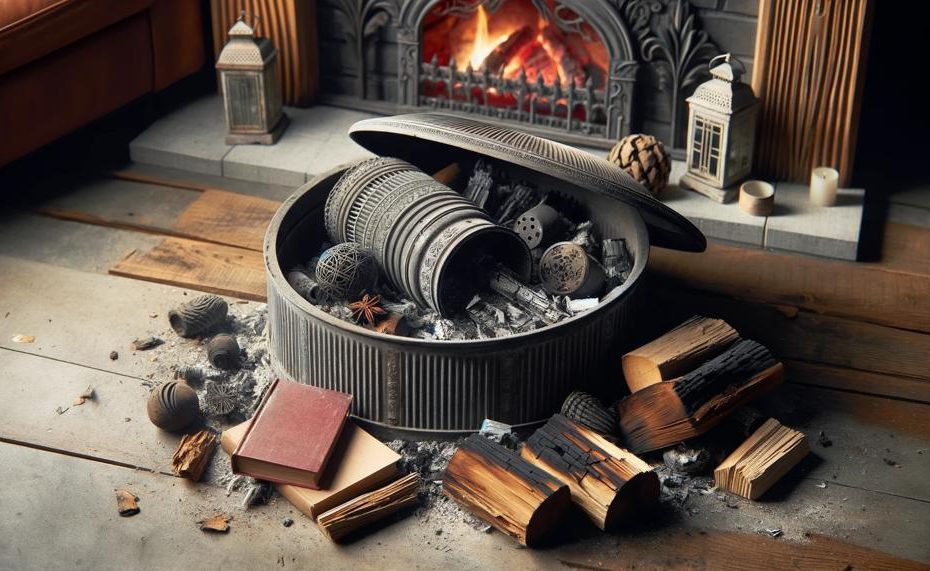Were you aware that incorrect disposal of hot ashes causes almost 10,000 fires annually in the United States? During the warm, fire-lit winter months, many homeowners fail to consider the hazards connected with the proper disposal of fireplace ashes.
No matter how much or how little experience you have with fireplaces, it is important to know how to properly dispose of ash for your own safety and the sake of the environment.
Fireplaces are a great way to warm yourself on cold nights and provide a special touch to your home. Careful management after a fire is essential to preserving this tranquil scene. Inadequate disposal of fireplace ashes may lead to disastrous outcomes, such as unintentional fires and significant harm to the environment.

Key Takeaways:
- Safety First: Allow ashes to cool for at least 24 hours in a metal container.
- Right Tools for the Job: Always use a metal bucket with a lid to prevent embers from escaping.
- Mindful Disposal: Never place ashes in plastic containers or bags, as they can easily ignite.
- Environmental Consideration: Consider composting your ashes to enrich your garden soil, providing vital nutrients to your plants.
Keep reading to delve deeper into the safe disposal methods that protect both your home and nature, ensuring that the comfort of your fireside doesn’t turn into a liability.
Contents
Let it All Chill Out
To ensure the safe disposal of fireplace ashes and prevent accidental fires or environmental harm, follow these comprehensive guidelines:
- Let It All Chill Out: Allow ashes to fully cool before disposal. Ideally, leave them in the fireplace for at least 24 hours after the fire has died.
- Metal Is Your Friend: Use a metal container with a tight-fitting lid to store and transport ashes. This reduces the risk of stray embers igniting nearby combustibles.
- Transfer Safely: Employ a metal shovel for transferring ashes to the metal container, minimizing the chance of hot debris escaping.
- Secure Storage: Keep the metal container outside, away from all flammable materials, until disposal.
- Damp Down: To extinguish any remaining embers, lightly dampen the ashes before sealing the container.
- Follow Local Guidelines: Dispose of the ashes according to local regulations—usually in a non-combustible area or with regular trash if completely cooled and dampened.
- Environmental Caution: Avoid using ashes in gardens or compost unless they are from purely wood sources, and even then, use sparingly to balance soil pH.
- Personal Safety: Always wear protective gloves when handling ashes to avoid skin irritation or burns.
Transfer the Ash and Coals to a Metal Container
To safely transfer ash and coals from a fireplace to a metal container for disposal, it is crucial to adhere to a series of specific steps to ensure safety and prevent accidental fires.
Below, I have detailed the process using a clear, concise table format that can be easily integrated into a WordPress blog.
| Step | Action | Details |
| 1 | Allow Cooling | Wait until the ash and coals have completely cooled. This may take several hours or overnight. |
| 2 | Choose the Right Tool | Use a metal shovel or scoop. Ensure it is sturdy and has no plastic components that could melt or ignite. |
| 3 | Select an Appropriate Container | Opt for a galvanized steel bucket or trash can with a lid and handle, suitable for the volume of ash. |
| 4 | Transfer Ash | Gently scoop the cooled ashes and carefully transfer them to the metal container. Avoid stirring the ash too much to prevent dust. |
| 5 | Secure the Container | Ensure the container’s lid is tightly closed and store it away from any flammable materials until ready for disposal. |
| 6 | Safe Disposal | Once confirmed cool, transport the container to a designated disposal area, ensuring it’s away from vegetation and flammable materials. |
By following these steps, you will not only safeguard your environment but also ensure that the process of disposing of fireplace ashes is managed in a responsible manner.
Take It Outside and Hose it Down
Hosing down fireplace ashes outside is a crucial step in safely disposing of them. This method ensures that any lingering embers within the ashes are thoroughly extinguished, preventing the risk of accidental fires when the ashes are subsequently handled or disposed of. Here’s a detailed breakdown of the process and its benefits:
- Extinction of Embers: Wetting the ashes cools any hidden embers, which might still be burning beneath the surface. This step is vital because these embers can remain hot enough to ignite a fire for several days if not properly addressed.
- Safe Handling: Once the ashes are drenched and embers are extinguished, the risk of them igniting materials like garden waste or trash bags is significantly reduced. This makes the subsequent handling and transport of the ashes safer.
- Preparation for Disposal: Wetting helps compact the ashes, making them less likely to blow away as dust during disposal. This containment is particularly important in preventing the spread of ash into unwanted areas where they could pose health or environmental hazards.
Below is a table detailing the process of hosing down fireplace ashes and the specific benefits each step provides:
| Step | Action | Benefit |
| Allow Ashes to Cool | Leave the ashes in a metal container for a few days after the fire has ceased. | Reduces the temperature of the ashes, making them safer to handle. |
| Drench with Water | Thoroughly soak the ashes with a hose or buckets of water. | Extinguishes all remaining embers and coals, preventing accidental ignition. |
| Secure and Dispose | Transfer the wet ashes to a bag and secure for disposal. | Ensures the ashes remain contained and are ready for safe removal with household trash. |
Keep it Outside Until its Removed
Strong safety steps must be taken when putting hearth ashes outside until they can be taken away. By taking these steps, the ashes won’t hurt anyone or damage property. Here is an organized way to safely handle and store hearth ashes:
- Cooling Off: Always allow ashes to cool fully before you transfer them from the fireplace. This can take several days.
- Proper Containers: Use a metal container with a tight-fitting lid to prevent oxygen from igniting any residual embers. Ensure the container is sturdy and rust-resistant.
- Safe Location: Store the metal container on a non-flammable surface such as concrete or bare earth. Keep it away from all flammable materials like wood, leaves, or chemicals.
- Regulatory Compliance: Familiarize yourself with and adhere to your local area’s guidelines for ash disposal, which might specify container types, storage locations, and disposal methods.
- Transportation Safety: When transporting ashes for disposal, secure the container in your vehicle to avoid spills that could lead to accidents or fires.
- Alternative Uses: If you’re using fireplace ash in your garden or elsewhere, handle it with care to avoid inhaling dust or direct contact with skin.
- Personal Safety Gear: Wear appropriate protective gear such as gloves, a dust mask, and eye protection when handling ashes.
Conclusion
Disposing of fireplace ashes safely is paramount to preventing accidental fires and environmental harm, a responsibility that shouldn’t be taken lightly.
With nearly 10,000 fires each year in the U.S. linked to improper ash disposal, adopting correct practices is not merely beneficial—it’s a necessity. Safeguard your home and nature by ensuring ashes cool completely in a metal container, ideally for 24 hours, before handling.
This container, equipped with a tight-fitting lid, should be used to store and transport ashes, and kept outdoors away from flammable materials. Minimize risks by transferring ashes using a metal shovel, dampening them to extinguish any lingering embers, and adhering to local disposal regulations.
If considering using ashes in your garden, do so sparingly and ensure they come from pure wood sources to maintain soil health. Protect yourself with gloves and avoid direct contact with the ashes.
By conscientiously following these steps, the warm glow of your fireplace remains a safe and cherished comfort rather than a hidden hazard.





